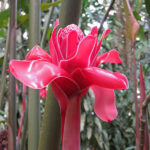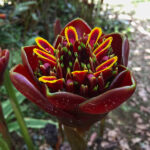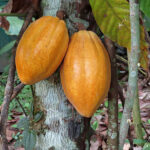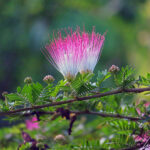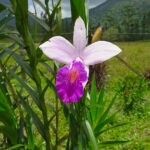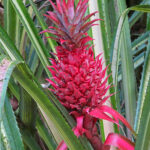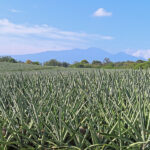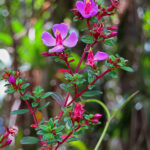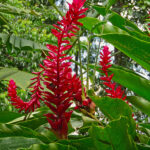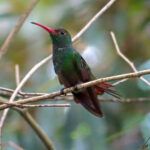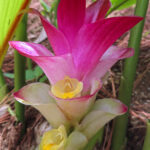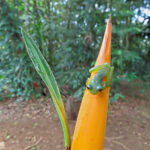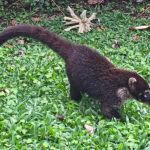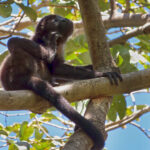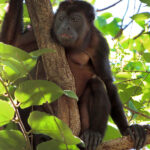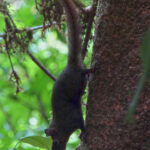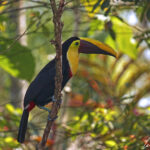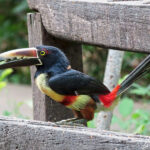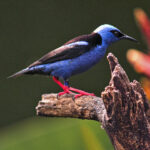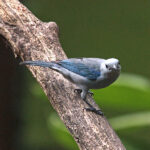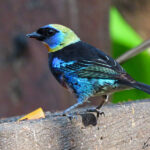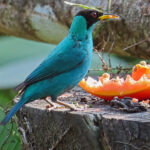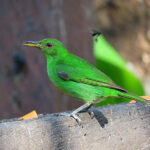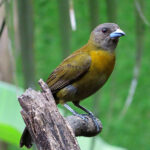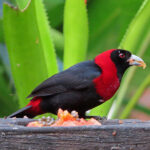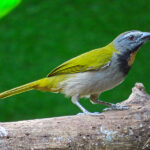How about a breath of fresh air in the heart of the Arenal Volcano National Park in Costa Rica ? This tiny Central American country is a vast nature sanctuary! The sumptuous Arenal Volcano National Park seduces in multiple ways: its omnipresent nature, its incredible biodiversity, its fauna, and especially its flora. The park was established in 1995. The Arenal Volcano National Park offers astonishing biodiversity, gathering more than half the species of mammals, reptiles, and birds observed in Costa Rica. In the Arenal National Park, under the aegis of the eponymous volcano, we discover, with the eyes of an amazed child, incredible endemic fauna and flora along the forest paths. Experienced and amateurs ornithologists will be delighted: approximately 500 species of birds have been identified in the park, about 53% of all the country’s birds. Travelers, let us begin the adventure! Let us discover this green Eden, a nature populated by multicolored tropical flowers, birds and colorful butterflies, lizards, iguanas, howler monkeys, and sloths.
« Walking, in a Paradise or Eden, whoa temptation, Give me one second to succumb. »
(Kate Bush – Pick the rare flower)
The flora of Arenal Volcano National Park
Did you know that according to the National Institute of Biodiversity, there are more than 12,000 varieties of plants in Costa Rica? Even the most experienced botanist is surprised by the richness of the flora and the number of endemic plants. The Arenal Volcano National Park has a very diverse flora due to its varied landscapes. The volcanic soil is rich in minerals; thus, everything grows superbly. On the plain, ornamental plants and fruit trees are cultivated: torch ginger (Etlingera elatior), orange, cacao, and banana trees, to mention a few. Costa Ricans love flowers and plants. Even the most humble house has a beautiful garden for all to see !

Rain tree flowers formed by filament of stamens (pink-red at the top and white at the base).
Wandering the many marked trails around the Arenal volcano, you will have the impression of walking through a beautiful terrestrial garden. The infinite greenery is punctuated by flowering trees like this Samanea saman, also known as the rain tree, and tropical flowers. The discreet and majestic orchids are among the local stars. There are more than 1,400 species, 20% of which are endemic to Costa Rica. We are carried away into a fairytale world, a palette of colors, sizes, and shapes. We find the Platystele genus, including about 95 species of orchids. Most of the species have miniature flowers, such as the Platystele tica, whose flower measures less than 1 mm, making it a challenge to appreciate its beauty. The elegant mauve orchid with a white heart, « La Guaria Morada », has been the country’s national flower since 1939. In 1972, under the presidency of José Figueres Ferrer, the second week of March was established as the week of Costa Rican Orchids. A true national treasure, the Talolingas (Roberto Gutiérrez and Carlos López) have dedicated and composed a song that all Costa Ricans know to this flower:
« Sobre la tapia entejada
sus pétalos suaves agita
la linda GUARIA MORADA
flor de esta tierra bendita ».
(La Guaria Morada – Los Talolingas)

The flower of the Bamboo orchid is pale pink with amethyst tip, and the labellum spotted.
The bromeliads, beautiful exotic plants, are the epiphytes often found in large quantities in tropical rainforests. You probably know them because they are sold commercially in Europe and elsewhere as houseplants because of their spectacular flowering and unusual foliage. The most famous of the bromeliads was introduced in Spain in 1493 by Christopher Columbus. Its name comes from its name in the Tupi-Guarani language: naná naná « perfume of perfumes ». The pineapple includes eight species of ornamental varieties (Ananas bracteatus) It is recognized by its long, sword-shaped, prickly, and leathery leaves. It has become the flagship product of Costa Rica, the number-one producer, and exporter of pineapples worldwide. It is on every supermarket shelf. Who has not eaten a Costa Rican pineapple ? However, in the interior of the country, this fruit is relatively unpopular. Formerly lush forests have been transformed into pineapple fields that have burned the soil with the enormous amount of chemicals needed for its production (fertilizers, herbicides, and pesticides.) Furthermore, some villages are no longer be able to use their groundwater because these products have poisoned it. If the environmental danger is more than obvious, the social impact causes a growing malaise: workers’ diseases, low wages, and difficult working conditions. Costa Rica, a small green paradise, still has ecological challenges to face: the « Pura Vida » has been put to the test by the American multinationals in charge of the pineapple fields (the Pineapple Development Corporation-Del Monte controls 50% of Costa Rican production) !

The variety ananas bracteatus has a red inflorescence and a variegated foliage.
Let us go back to the fairytale of our exotic garden with Monochaetum vulcanicum, a species endemic to Costa Rica: beautiful pink flowers on a background of green leaves. During your hikes, you will come across other remarkable species such as the flamboyant Alpinias in the ginger family, which offer a festival of color from pink to white to flamboyant red. The Heliconias are equally colorful and can be recognized by their spectacular spikes of inflorescences, erect or hanging, which color the forest with their glowing hues. Heliconia is especially popular with hummingbirds like this Rufous-tailed hummingbird, but Heliconia is also treacherous. The Schlegel’s viper, known as eyelash viper, loves to hide in its fruits to swallow an unfortunate hummingbird that has come by…
« In the subconscious of the ancients, where all the myths were born, one could not believe that the plant and the flowers were anything other than the image the gods wanted to show us ».
(De Jean de la Bosschère – La Fleur et son parfum)

Heliconias are sometimes called lobster claws or parrot flowers
We need to take time to look at the different plants hanging on the trunks of trees and to scrutinize our surroundings carefully. Impatiensthrive in the shade of a stump. Further along our path, Zingiber spectabile, more commonly known as Beehive ginger, releases a pleasant ginger smell. A little further on, we bump into its close cousin, curcuma longa, which also belongs to the ginger family. In both cases, the aromatic rhizomes are used to make the spice. Although attractive, this Star of Bethlehem (Hippobroma longiflora) must be handled with extreme caution. Also called « Death to cows » or « Death to goats », its milky sap contains irritating substances which can be absorbed through the skin. Even a tiny amount of this sap in the eyes can cause blindness. Its ingestion is highly toxic because it contains two pyridine alkaloids: lobeline and nicotine. Lobeline and nicotine have unpleasant psychoactive effects even in a small dose. These include vomiting, muscular paralysis, and tremors at high doses. Thus, it is advisable to admire this fatal beauty from some distance – Mother Nature in her most fascinating, but also most treacherous, form !
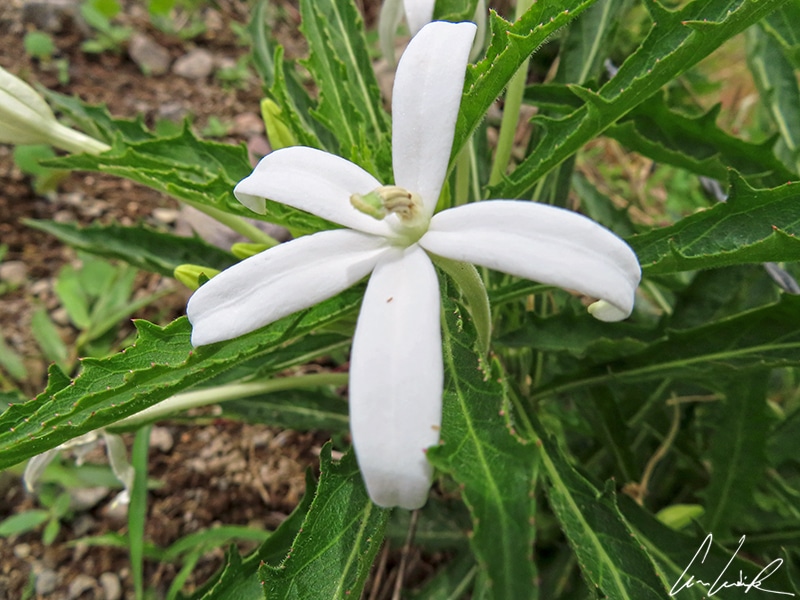
The Hippobroma longiflora is nicknamed the Star of Bethlehem.
The fauna of the Arenal Volcano National Park
To penetrate undisturbed nature, to move into a preserved ecosystem, this is the attraction of Costa Rica. The Arenal Volcano National Park ecosystems are diverse, and it is easy to observe certain animals: iguanas, coatis, toucans, frogs, and many species of birds. Every year, new specimens are discovered like the Kermit frog, alias Hyalinobatrachium dianae, also known as Diane’s bare-hearted glass frog, a look-alike to Kermit the Frog, the famous character of The Muppet Show. This frog was first discovered only in 2015 in the pre-mountainous forest of Talamanca in the Northeastern region of Costa Rica. Hyalinobatrachium dianae is a species of “glass frog” in the Centrolenidae family. Fairy tales have accustomed us to glass slippers and frogs turning into Prince Charming after a sweet kiss, but a glass frog ? Seen from the back, this small glass frog, roughly one inch long, seems banal. However, despite its smallness, it croaks like a big one. It is lime green in color, but a glimpse of its belly reveals its anatomical anomaly: its skin is translucent, allowing us to see its internal organs. Hence the name « glass frog ». There is no precise explanation for the evolution of this complete ventral transparency, but that does not prevent researchers from proposing hypotheses while waiting to discover the secret of the glass frog at midnight after a ball…
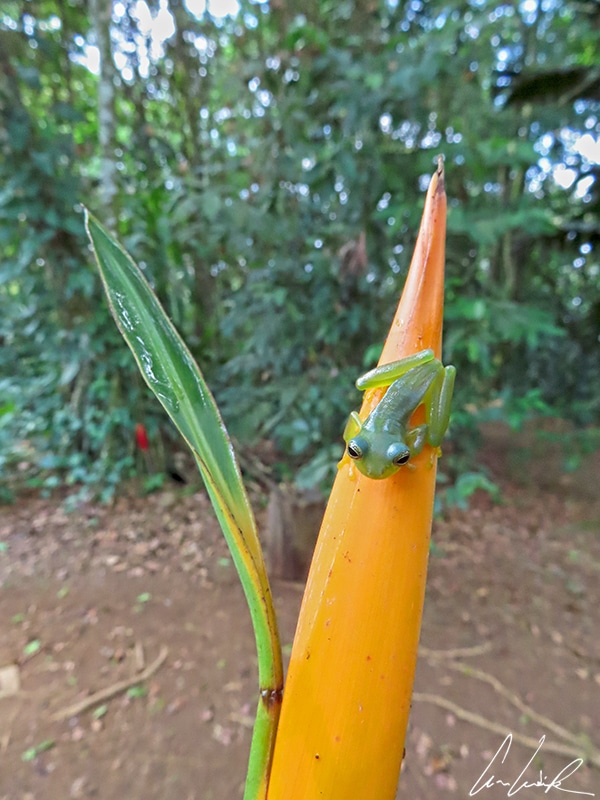
The glass frog deserves its name to the transparency of its skin on the abdomen.
What other surprises does this incredible Noah’s Ark contain ? The White-nosed coati is frequently seen in the Arenal Volcano National Park, mainly because this mammal is curious and not very shy. Recognizable by its long white pointed snout and very mobile black nose, the coati is a social animal that lives in groups of 4 to 25 individuals. Coatis spend most of their day looking for food and only interrupt this activity from time to time to wash themselves… They are a member of the Procyonidae family, the same as raccoons! They climb trees with ease, using their tail is for balance while climbing and moving from branch to branch.
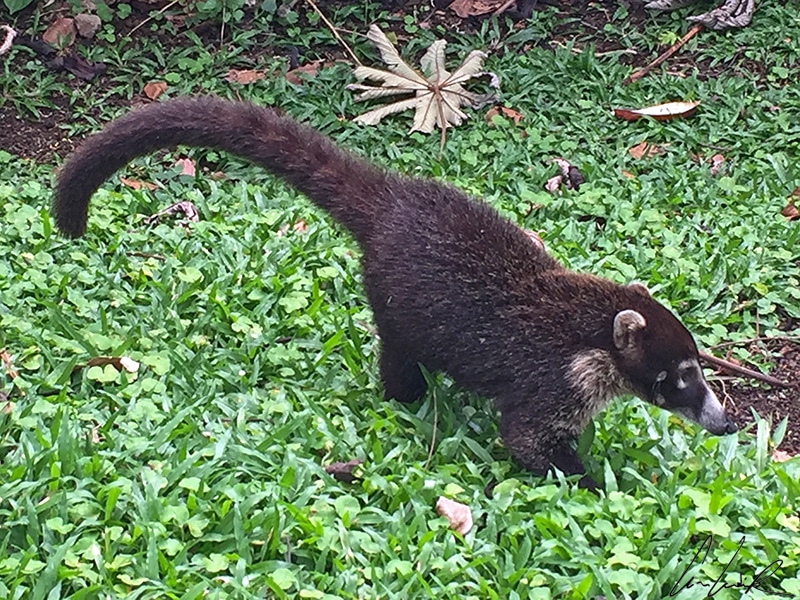
The white-nosed coati (or brown coati) owes its name to the white spots on its snout.
The coatis must sometimes share the trees with Howler monkeys, which give a wake-up call in the form of a loud, long, hoarse, and lugubrious howl. This call can be heard up to several miles away, and we expect to see King-Kong in person… It is nothing of the sort. It measures only 22 to 36 inches, excluding its tail, which can be equally as long. Howler monkeys have a prehensile tail, which serves as their fifth leg, and can grasp and hold objects… If coatis spend their day looking for food, the Howler monkey is lazy, spending three-quarters of its day resting. When it senses danger, the Howler monkey goes on the run by howling – it has to earn its status as the loudest animal in the world in the book of records and by defecating on its aggressor. All kinds of animal encounters are possible while walking on the park paths: an Iguana climbs on a tree while a Squirrel descends. With a bit of luck, your path will cross that of a Peccary, a Tapir, a Capuchin monkey, a Sloth, an Agouti (Dasyprocta punctata), and more improbably, a Jaguar. The agouti is a small rodent. It can reach 2 feet in length and 8.8 pounds of weight. Tail can be 0.4 to 1.4 inches long. It has such a great sense of hearing that it can hear fruit hit the forest floor. It also boasts an exceptional sense of smell, hiding any extra food that it may have and later locating it with its nose. Agoutis scatter and bury the nuts for future consumption, but some nuts manage to sprout and grow into mature trees. They sometimes act like « gardeners of forests ».

Howler monkey has prehensile tail, or tail that can grip
Arenal Volcano National Park: a park filled with exotic birds !
The Arenal Volcano National Park hosts approximately 500 species of birds, which is about 53% of the birds of Costa Rica, a true paradise for ornithologists of all kinds. It is hard not to fall under the spell of the great diversity of exotic birds and their peaceful and melodious song, so pleasant to hear in the middle of nature. But a question is on my mind: will you be able to distinguish them one from the other ?

The Collared Aracari is a colorful small toucan
Let us start with one of Costa Rica‘s iconic birds: the Toucan ! Look up because they live primarily at the top of trees. The most popular of the family, which includes six species found in the country, is the Carina toucan, also known as the Rainbow-billed Toucan (Ramphastos sulfuratus). It is famous for its large and rainbow-like-colored bill that averages around 4.7 – 5.9 inches, one-third of its overall length (17 to 22 inches.) The most common is the Chestnut-mandibled Toucan, also called Swainson’s Toucan (Ramphastos ambiguous swainsonii) with its massive two-colored bill and blue legs. The bill is lemon-yellowish on the upper side and blackish on the underside. The Chestnut-mandibled Toucan, a subspecies of the Yellow-throated Toucan, is larger than the Rainbow-billet Toucan. Its length is around 19-24 inches total, and the bill about 5 – 8 inches. There is also the Collared aracari toucan (Pteroglossus torquatus). Like other toucans, it has a large colorful bill. However, contrary to the others, it is smaller in length, about 16 inches. The Aracari has a much longer and harder bill. Toucans are not easy to observe because they often hide in the heights of trees. While they have a streamlined and graceful flight over the tops of the tallest trees, their gait on the ground is somewhat awkward and bouncy. Their long, characteristically shaped bills are easily recognizable and account for between 30 and 50% of their body surface area. In Central America, the Toucan is nicknamed « flying banana ». While the bill seems massive and cumbersome, it is a spongy and hollow bone made of keratin, a very light and hard protein, like our fingernails. The bill grows throughout the bird’s life to compensate for the wear and tear caused by its use.
« A person who saw a Toucan for the first time might think the head and the bill, viewed from the front, as one of those long-nosed masks that frighten children; but when he seriously examines this enormous production, he would be surprised that nature had given so huge a bill to a bird of such moderate size, and his astonishment would increase upon reflecting that it was useless and even burdensome to its owner because it obligated the bird to swallow its food whole without chewing ».
(The Natural History of Birds, Vol. 7, page 103 by Georges-Louis Leclerc de Buffon, Naturalist from the 18th century)
So what is the purpose of such a bill ? To help the bird smell ? Well, no, since toucans, like the vast majority of birds, have no sense of smell. To sing? According to some ornithologists, the bill could indeed be used as a resonance box to increase the range of its song. To seduce its partners or to intimidate its enemies ? The most widespread hypothesis is that the Toucan’s bill is mainly used to reach the fruits located at the fragile and thin ends of the branches, which would not support its weight. However, this was without counting a new Canadian lead… Observed with infrared thermography, researchers have shown that toucans use their bills, extensively irrigated by blood vessels, to reduce their body heat. In a few minutes, the Toucan can increase or decrease the temperature of its bill by 10 degrees. The bill is a remarkable air-conditioner radiator, just like the ears of elephants! However, it is estimated that this radiator bill is four times more efficient than elephants’ ears. When resting, toucans often place their bill in their back feathers while turning their head, or they may even tuck it under a wing… as if to keep it warm under a real feather comforter. No better way to spend a night !
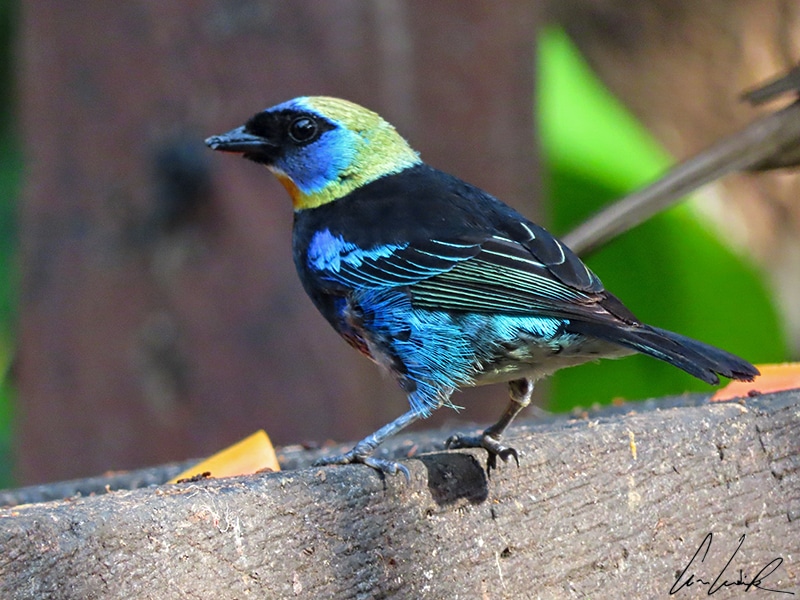
A Golden-hooded Tanager male
More difficult now. Another family of birds is widespread in Costa Rica: the Thraupidae, a family of passerines consisting of a hundred genera and containing nearly 400 species such as Tanager, Callist, or Guitguits. The ornithological future belongs to those who get up early! You must be an early riser to observe these birds because they are mainly active at sunrise and sunset! Indeed, as soon as they wake up, they go in search of food and must also defend their territory. It is also necessary to be patient… But shhh, here begins the morning parade in full color: all dressed in blue. Here are the Red-legged honeycreeper and the Blue-gray tanager (Thraupis episcopus) followed by the Golden-hooded Tanager (Tangara larvata), also called Tangara larvata fanny or Yellow-headed tanager. Like many tanagers, it moves in couples or very small groups, including other species. By the way, here is Mr. and Mrs. Green honeycreeper (Chlorophanes spiza.) The male has mainly a blue-tinted green body with a black head and mostly bright yellow bill. The female has apple-green plumage, paler on the throat. The same sexual dimorphism is found in the Scarlet-rumped tanager(Ramphocelus passerinii). As the name mentioned, the adult male is unmistakable with its blue bill, black plumage, and scarlet rump. The female is very different. She has the same bluish bill but a greyish head, olive underparts becoming brighter and paler on the rump, brownish wings and tail, and also ochre underparts. She must prefer to be called by another name! If the tanagers have beautiful colored plumage, they are generally poor singers. We cannot have everything. Another interesting characteristic is that these birds practice participative breeding during which the young of the previous brood assist their parents.

The Crimson-collared tanager
We thought the morning parade was coming to an end. However, a crimson-collared tanager (Ramphocelus sanguinolentus), a Stripe-backed tanager (Piranga bidentata), and then a Buff-throated saltator (Saltator maximus), with its olive plumage, white eyebrows, and buff throat edged with black all come by. The various colors of the plumage are due to pigments. Most feather pigments are melanins (black and beige pheomelanin and black and grey eumelanins) – and carotenoids (yellow, orange, red) set up during molting. These pigments absorb part of the light, or they diffract it. Thus the absorption of green and blue light by a pigment will turn red to the eye. But there is a second mechanism called « structural coloration »: Structural colors are decompositions of light by diffraction, this diffraction being possible thanks to the nanostructure of feathers. It should be known, for example, that blue pigments do not exist in birds: the beautiful blue cameos are therefore structural colors. The advantage is that this beautiful blue plumage does not fade with age, unlike our hair which turns gray. It keeps an intense and unalterable blue for life. Scientists have shown that tiny holes of varying sizes in the feather barbules allow for different colors. Indeed, when the light reaches one of the holes, it is reflected differently according to the diameter of the hole. For example, holes that measure 150 nanometers will give a blue coloring to the feather, while holes of 200 nanometers will induce a white coloring. But for some shades of our tanagers, the network of « small holes » is not enough ! To obtain a black or at least dark coloration, melanin becomes necessary. The most difficult color to obtain for the plumage is green because it requires holes of adequate diameter and yellow pigments. It is a combination of still mysterious mechanisms between different pigments and optical phenomena that allows such a great variety of colors. This art of color-creating nanostructures, inspired directly by nature, is a constant source of inspiration for scientists searching for imagination. Imitating bird feathers to recreate the shimmering colors of nature opens new perspectives in the creation of synthetic colors for paints or for clothes that would no longer fade in the wash !
Find more on Costa Rica
- Explore the cloud tropical forests of Costa Rica
- Costa Rica: A Vast Reservoir of Biodiversity
- Arenal Volcano National Park, a natural wonder
- Tenorio Volcano National Park, the most wonderful !
- The Caño Negro Refuge: Pointed teeth and Feathers along the Water
- The head in the clouds in the Reserve of Monteverde
- Exploring the Costa Rican Pacific coast: the Carara National Park
- Exploring the Costa Rican Pacific coast: the Manuel Antonio Park

